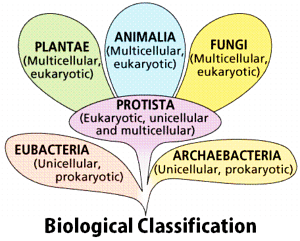Enzymes not found in:
- Fungi
- Algae
- Virus
- Cyanobacteria
The Correct Option is C
Solution and Explanation
Enzymes are biological molecules and are indeed found in all living organisms, including fungi, cyanobacteria, and algae. Viruses, however, are not considered living organisms and do not possess enzymes.
So, the correct option is (C): Virus
Top Questions on Biological Classification
- Match List I with List II
List I List II A Typhoid I Fungus B Leishmaniasis II Nematode C Ringworm III Protozoa D Filariasis IV Bacteria
Choose the correct answer from the options given below:- NEET (UG) - 2024
- Biology
- Biological Classification
- Match List I with List II
List I List II A. Spongilla I. Coelenterata B. Fasciola II. Porifera C. Adamsia (Sea anemone III. Annelida D. Hirudinaria IV. Platyhelminthes
Choose the correct answer from the options given below:- CUET (PG) - 2023
- Biology
- Biological Classification
- The mode of nutrition in Paramoecium ____ .
- TS POLYCET - 2022
- Biology
- Biological Classification
Match Column - I with Column - II.
List - I List - II (a) Metamerism (I) Coelenterata (b) Canal system (II) Ctenophora (c) Comb plates (III) Annelida (d) Cnidoblasts (IV) Porifera Choose the correct answer from the options given below.
- NEET (UG) - 2021
- Biology
- Biological Classification
- Identify the diagram of heterocyst.
- JIPMER MBBS - 2019
- Biology
- Biological Classification
Questions Asked in NEET exam
- A thin flat circular disc of radius 4.5 cm is placed gently over the surface of water. If surface tension of water is 0.07 Nm-1, then the excess force required to take it away from the surface is :
- NEET (UG) - 2024
- Surface tension
- Which of the following are required for the dark reaction of photosynthesis?
A. Light
B. Chlorophyll
C. CO2
D. ATP
E. NADPH
Choose the correct answer from the options given below:- NEET (UG) - 2024
- Where Does Photosynthesis Take Place?
- If \(x=5\sin(\pi i+\frac{\pi}{3})m\) represents the motion of a particle executing simple harmonic motion, the amplitude and time period of motion, respectively, are :
- NEET (UG) - 2024
- simple harmonic motion
- The highest number of helium atoms is in
- NEET (UG) - 2024
- Electronic configuration of atoms and ions
- \(^{290}_{82}X\stackrel{\alpha}{\rightarrow}Y\stackrel{e^+}{\rightarrow}Z\stackrel{\beta^-}{\rightarrow}P\stackrel{e^-}{\rightarrow}Q\)
In the nuclear emission stated above, the mass number and atomic number of the product Q respectively, are :- NEET (UG) - 2024
- Nuclear physics
Concepts Used:
Biological Classification
The process of grouping living organisms into categories is called biological classification. The most modern 5-kingdom classification was put ahead by an eminent scientist R.H.Whittaker. The five-kingdom classification is based on the criteria like cell structure, mode of nutrition, body form, and reproduction. One of the most important characteristics of this system is that it follows the evolutionary sequence of living organisms. The organisms are classified into distinct taxa or levels like Kingdom, Phylum, Division, Class, Order, Family, Genus, and Species. The 5 kingdoms are as follows:




